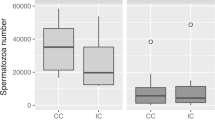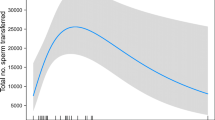Abstract
Sexual selection may operate on pre-copulatory, copulatory, and post-copulatory traits. An example of a copulatory target of sexual selection is the genitalic movements a male performs during copulation. These movements may function either to prevent sperm competition or to influence a female’s fertilization decision. Here we investigated how copulation duration, pedipalp movements, and abdominal movements that males of the pholcid spider Holocnemus pluchei produce during copulation influence sperm removal and/or patterns of successful sperm transfer. We compared mating events with virgin and mated females for differences in copulatory and post-copulatory behavior. We expected longer copulation duration, longer pedipalp movement duration, and more complex and frequent pedipalp and abdominal movements when males mated with mated females compared to virgin females. Except for abdominal movements, our results corroborated these predictions. Furthermore, when we investigated mating events with mated females, we observed sperm mass ejection from the female gonopore and physical removal of sperm by males’ procursi. Females with interrupted second mating events showed a significant reduction of stored sperm masses compared to females with completed mating events. We suggest that males use alternating pedipalp movements to remove most of the rival sperm stored by mated females prior to sperm transfer. Copulation duration and pedipalp movements can be further used to transfer sperm and/or as a form of genitalic copulatory courtship.








Similar content being viewed by others
References
Aisenberg A (2009) Male performance and body size affect female re-mating occurrence in the orb-web spider Leucauge mariana (Araneae, Tetragnathidae). Ethology 115:1127–1136
Aisenberg A, Costa FG (2005) Females mated without sperm transfer maintain high sexual receptivity in the wolf spider Schizocosa malitiosa. Ethology 111:545–558
Andrés J, Cordero Rivera A (2000) Copulation duration and fertilization success in a damselfly: an example of cryptic female choice? Anim Behav 59:695–703
Austad SN (1984) Evolution of sperm priority patterns in spiders. In: Smith RL (ed) Sperm competition and the evolution of mating systems. Harvard University Press, Cambridge, pp 223–249
Blumstein D T, Evans C S, Daniel J C (2000) JWatcher. http://galliform.psy. mq.edu.au/jwatcher/. Accessed 20 Nov 2008
Burger M (2007) Sperm dumping in a haplogyne spider. J Zool (Lond) 273:74–81
Calbacho-Rosa L, Córdoba-Aguilar A, Peretti A (2010) Occurrence and duration of post-copulatory mate guarding in a spider with last sperm precedence. Behaviour 147:1267–1283
Coddington JA, Levi HW (1991) Systematics and evolution of spiders (Araneae). Annu Rev Ecol Syst 22:565–592
Córdoba-Aguilar A (1999) Male copulatory sensory stimulation induces female ejection of rival sperm in a damselfly. Proc R Soc Biol Sci Ser B 266:779–784
Córdoba-Aguilar A, Uhía E, Cordero Rivera A (2003) Sperm competition in Odonata (Insecta): the evolution of female sperm storage and rivals’ sperm displacement. J Zool (Lond) 261:381–398
Eberhard WG (1991) Copulatory courtship and cryptic female choice in insects. Biol Rev 66:1–31
Eberhard WG (1994) Evidence for widespread courtship during copulation in 131 species of insects and spiders, and implications for cryptic female choice. Evolution 48:711–733
Eberhard WG (1996) Female control: sexual selection by cryptic female choice. Princeton University Press, Princeton
Eberhard WG (2001) The functional morphology of species-specific clasping structures on the front legs of male Archisepsis and Palaeosepsis flies (Diptera, Sepsidae). Zool J Linn Soc 133:335–368
Eberhard WG (2004) Why study spider sex: special traits of spiders facilitate studies of sperm competition and cryptic female choice. J Arachnol 32:545–556
Eberhard WG (2009) Postcopulatory sexual selection: Darwin’s omission and its consequences. Proc Natl Acad Sci USA 106:10025–10032
Eberhard WG (2011) Experiments with genitalia: a commentary. Trends Ecol Evol 26:17–21
Edvardsson M, Arnqvist G (2000) Copulatory courtship and cryptic female choice in red flour beetles Tribolium castaneum. Proc R Soc Biol Sci Ser B267:559–563
Elgar MA, Bathgate R (1996) Female receptivity and male mate-guarding in the jewel spider Gasteracantha minax Thorell (Araneidae). J Insect Behav 9:729–738
Foelix RF (1982) The biology of spiders. Harvard University Press, Cambridge
Herbestein ME (2011) Spider behaviour: flexibility and versatility. Cambridge University Press, Cambridge
Huber BA (1995) Copulatory mechanism in Holocnemus pluchei and Pholcus opilionoides, with notes on male cheliceral apophyses and stridulatory organs in Pholcidae (Araneae). Acta Zool (Stockh) 76:291–300
Huber BA (1998) Genital mechanics in some neotropical pholcid spiders (Araneae: Pholcidae) with implications for systematics. J Zool (Lond) 244:587–599
Huber BA (2005) Sexual selection research on spiders: progress and biases. Biol Rev 80:363–385
Huber BA, Eberhard WG (1997) Courtship, copulation, and genital mechanics in Physocyclus globosus (Araneae, Pholcidae). Can J Zool 74:905–918
Jakob EM (1991) Costs and benefits of group living for pholcid spiderlings: losing food, saving silk. Anim Behav 41:711–722
Kaster JL, Jakob EM (1997) Last-male sperm priority in a haplogyne spider (Araneae: Pholcidae): correlations between female morphology and patterns of sperm usage. Ann Entomol Soc Am 90:254–259
Kelly CD, Jennions MD (2011) Sexual selection and sperm quantity: meta-analyses of strategic ejaculation. Biol Rev 86:863–884
Leonard J, Córdoba-Aguilar A (eds) (2010) The evolution of primary characters in animals. Oxford University Press, Oxford
Marcotte M, Delisle J, McNeil JN (2005) Impact of male mating history on the temporal sperm dynamics of Choristoneura rosaceana and C. fumiferana females. J Insect Physiol 51:537–544
Michiels NK (1989) Morphology of male and female genitalia in Sympetrum danae (Sulzer), with special reference to the mechanism of sperm removal during copulation (Anisoptera: Libellulidae). Odonatologica 18:21–31
Naud MJ, Hanlon RT, Hall KC, Shaw PW, Havenhand JN (2004) Behavioural and genetic assessment of reproductive success in a spawning aggregation of the Australian giant cuttlefish, Sepia apama. Anim Behav 67:1043–1050
Ono T, Siva-Jothy MT, Kato A (1989) Removal and subsequent ingestion of rivals’ semen during copulation in a tree cricket. Physiol Entomol 14:195–202
Otronen M (1990) Mating behavior and sperm competition in the fly, Dryomyza anilis. Behav Ecol Sociobiol 26:349–356
Otronen M, Siva-Jothy MT (1991) The effect of postcopulatory male-behavior on ejaculate distribution within the female sperm storage organs of the fly, Dryomyza anilis (Diptera, Dryomyzidae). Behav Ecol Sociobiol 29:33–37
Parker GA (1979) Sexual selection and sexual conflict. In: Blum MS, Blum NA (eds) Sexual selection and reproductive competition in insects. Academic Press, New York, pp 123–166
Peretti AV, Eberhard WG (2010) Cryptic female choice via sperm dumping favours male copulatory courtship in a spider. J Evol Biol 23:271–281
Peretti AV, Eberhard W, Briceño D (2006) Copulatory dialogue: female spiders sing during copulation to influence male genitalic movements. Anim Behav 72:413–421
Pilastro A, Scaggiante M, Rasotto MB (2002) Individual adjustment of sperm expenditure accords with sperm competition theory. Proc Natl Acad Sci U S A 99:9913–9915
Pizzari T, Birkhead T (2000) Female feral fowl eject sperm of subdominant males. Nature 405:787–789
Rodríguez V, Windsor D, Eberhard WG (2004) Tortoise beetle genitalia and demonstration of a sexually selected advantage for flagellum length in Chelymorpha alternans (Chrysomelidae, Cassidini, Stolaini). In: Jolivet P, Santiago-Blay JA, Schmitt M (eds) New developments in the biology of Chrysomelidae. Academic Publishing, The Hague, SPB, pp 739–748
Schäfer MA, Uhl G (2002) Determinants of paternity success in the Pholcus phalangioides (Pholcidae, Araneae): the role of male and female mating behaviour. Behav Ecol Sociobiol 51:368–377
Schäfer MA, Misof B, Uhl G (2008) Effects of body size of both sexes and female mating history on male behaviour and paternity success in a spider. Anim Behav 76:75–86
Simmons LW (2001) Sperm competition and its evolutionary consequences in the insects. Princeton University Press, Princeton, New Jersey
Snook RR, Hosken DJ (2004) Sperm death and dumping in Drosophila. Nature 428:939–941
Solensky MJ, Oberhauser KS (2009) Male monarch butterflies, Danaus plexippus, adjust ejaculates in response to intensity of sperm competition. Anim Behav 77:465–472
Uhl G (1994) Genital morphology and sperm storage in Pholcus phalangioides (Fuesslin, 1775) (Pholcidae: Araneae). Acta Zool (Stockh) 75:1–12
von Helversen D, von Helversen O (1991) Pre-mating sperm removal in the bush cricket Metaplastes Ramme 1931 (Orthoptera, Tettigonoidea, Phaneropteridae). Behav Ecol Sociobiol 28:391–396
Waage JK (1979) Dual function of the damselfly penis: sperm removal and sperm transfer. Science 203:916–918
Wada T, Takegaki T, Mori T, Natsukari Y (2006) Reproductive behavior of the Japanese spineless cuttlefish Sepiella japonica. Venus 65:221–228
Wada T, Takegaki T, Mori T, Natsukari Y (2010) Sperm removal, ejaculation and their behavioral interaction in male cuttlefish in response to female mating history. Anim Behav 79:613–619
Acknowledgments
We thank Margarita Chiaraviglio and Cristina Sciocia for suggestions on the manuscript. The authors also acknowledge D. Vrech and P. Olivero for help during collecting and rearing. Financial support was provided by the Consejo Nacional de Investigaciones Científicas y Técnicas, FONCYT, and Secretaria de ciencia y técnica–Universidad Nacional de Córdoba of Argentina and Agencia Nacional de Investigación, España. Four reviewers and Chris Anderson provided highly useful comments to previous versions.
Author information
Authors and Affiliations
Corresponding authors
Additional information
Communicated by: Sven Thatje
Electronic supplementary material
Below is the link to the electronic supplementary material.
Male carrying out alternating pedipalp movements, overview (MPG 3214 kb)
Male carrying out alternating pedipalp movements, detailed view (MPG 1720 kb)
Male carrying out simultaneous pedipalp movements (MPG 4272 kb)
Rights and permissions
About this article
Cite this article
Calbacho-Rosa, L., Galicia-Mendoza, I., Dutto, M.S. et al. Copulatory behavior in a pholcid spider: males use specialized genitalic movements for sperm removal and copulatory courtship. Naturwissenschaften 100, 407–416 (2013). https://doi.org/10.1007/s00114-013-1038-1
Received:
Revised:
Accepted:
Published:
Issue Date:
DOI: https://doi.org/10.1007/s00114-013-1038-1




